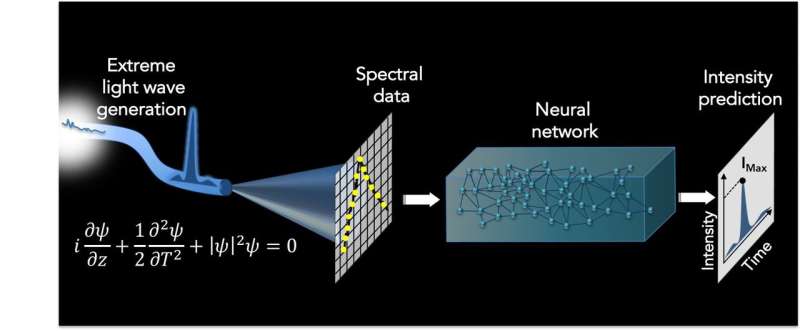Artificial intelligence predicts rogue waves of light

In a recent study published in Nature Communications, an international team of researchers from Tampere University of Technology (TUT), Finland, and the Institut FEMTO-ST at the Université Bourgogne-Franche Comté, France, take a significant step toward the analysis and predictability of rogue waves that appear seemingly out of nowhere.
Stories of giant ocean waves with great destructive power are the stuff of legend and folklore, but today their scientific study is a critical area of multidisciplinary research spanning oceanography, physics and mathematics. A particular problem faced by researchers is that these extreme waves arise seemingly randomly on the ocean's surface, and it appears impossible to predict the conditions that may precede their appearance. A related practical difficulty is that it is not always possible to measure such waves completely, and the available instrumentation most often captures only a portion of the wave characteristics.
In recent experiments studying analogous extreme waves of light, researchers have used artificial intelligence to study this problem, and have now determined a probability distribution that preferentially identifies the emergence of rogue waves. The particular novelty of this work is that the researchers trained a neural network to identify the particular time-domain properties of rogue waves with the highest and most extreme intensities from only partial information on the wave characteristics in the frequency or wavelength domain.
The experiments were performed by injecting laser pulses into an optical fibre system designed to reproduce wave propagation described by a nonlinear Schrödinger equation, a model that can also apply to water waves. Using an instrument developed especially to measure optical spectra in real time with high dynamic range, the researchers compiled a data set of thousands of noisy spectral signals from a nonlinear process called modulation instability, which is believed to be associated with some classes of rogue waves on the ocean.
Although optical spectra are easy to measure, they do not show the presence of rogue waves directly. But by using powerful numerical simulations to train a neural network, it was possible to develop an algorithm that could accurately pick out features in the spectra that predict the emergence of a rogue wave, even though these features were essentially invisible to the eye of a researcher.
"Remarkably, the algorithm was shown to be capable of predicting the peak intensity of a rogue wave associated with any particular spectral measurement, even though experiments never actually measured the rogue wave intensity directly," says Professor Goëry Genty, who led the team at Tampere University of Technology.
The results obtained yielded a probability distribution for the appearance of the optical rogue waves and were also used to classify the spectral measurements into different sets associated with different types of rogue waves.
"As well as suggesting that similar techniques can be used to analyse real-time measurements on oceanographic wave data, the results open new perspectives in all fields of research where direct time domain observations are difficult, but where spectral data is available," concludes Professor Dudley, who headed the team at the Université Bourgogne-Franche Comté.
More information: Mikko Närhi et al. Machine learning analysis of extreme events in optical fibre modulation instability, Nature Communications (2018). DOI: 10.1038/s41467-018-07355-y
Journal information: Nature Communications
Provided by Tampere University of Technology





















